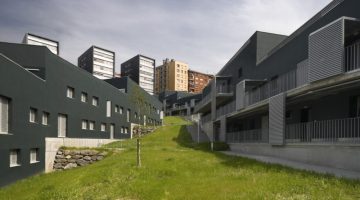



Bilbao, Spain
Main objectives of the project
Date
- 2005: Construction
Stakeholders
- Architect: Luis Díaz Mauriño
- Architect: Eduardo Belzunce
- Architect: Francisco Burgos
- Architect: Jose María de Lapuerta
- Architect: Juan García Millán
Location
City: Bilbao
Country/Region: Bilbao, Spain
Description
The site was a former iron mine, with a topography that had slopes of up to 50 meters, surrounded by a disorganized and degraded residential outskirts to the north and by the channelled Nervión River and the Miraflores peninsula and Miribilla to the south. The frontier character of the site and its ambiguous and hybrid qualities are preserved. A comb-shaped footprint of several towers separated by lookouts works as a visual filter from the urban environment behind, generating a new façade for the city, introducing order and repetition. In addition, is planned a low-rise, introverted, residential core surrounded by a taller permeter dedicated to offices, amenities, retail areas and civic buildings.
The perimeter acts both as a connector to the neighbourhood and the old road to San Sebastian, as well as a visual and acoustic barrier. On the other hand, the existing neighbourhood, which is very dense, needed porosity, so two sun-filled squares with views were preserved with the open spaces between towers acting as urban lookouts. In the core of the cluster, the buildings rise from a carpet of green spaces that act as intermediary spaces.
Six residential buildings spill randomly throughout the hill, almost like a river, without subordinating themselves to parallel alignments, but controlled by a rational geometry. The buildings, following the idea of long-tiered-sigzag, generate a series of exterior voids that get narrower and wider, creating an intermediate scale of communal spaces.
The mixed typology of the buildings combines the volume of the single-family row housing and the functionality of a social housing building with access through corridors. Each unit is accessed from the outside, with independence, provided by its individuality, but stacked one on top of each other, using the collective logic. The longitudinal orientation of the building, approximately north-south, determines that the access corridors, where the entry halls, kitchens, laundry rooms, and bathrooms are facing, need to look north. The south façade, facing the ideal sun conditions and views, is then dedicated to bedrooms and living rooms.
“End and top off the edge of town. It was the responsibility of the proposed architecture to order against confusion”.
“Convert the upper street to a viewer street. The buildings will mark, surprise with different views different from the other side”.
“Project houses to look to the landscape and noon, the park and the streets”.
“It is about Sewing vertically, assigning that role to the own building”.
The result all the premises of the place and the intentions on the project are five residential towers perched on a stepped base (due to the sharp slope) that absorbs all the sector garages which is accessed by a new street below; intermediate semi-public squares looking at the views across the Nervión; all the living rooms facing the midday sun.
